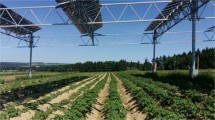Abstract
The determination and the assessment of Best Available Techniques (BAT) is one of the key issues in the realisation of the IPPC-Directive. While research has already focused on environmental benefits and technical practicability of techniques within LCA, little work has been carried out assessing economic feasibility. A methodology for the economic assessment of BAT in the framework of the IPPC-Directive on a plant level has to comprise all costs that accrue by measures to prevent, to reduce, to utilise or to remove emissions into water, air and soil caused by industrial production processes. The applied cost concept provides a systematic accounting and allocation of decision relevant costs and possibly revenues, that are pertinent to the economic assessment of BAT. The application of the methodology to a case study from the steel industry shows the practical use of the approach.
Similar content being viewed by others
References
Council of the European Union (ed.) (1996): Directive on Integrated Pollution Prevention and Control. Official Journal of the European Communities, No L 257, 10.10.1996, Brussels, p. 26–40
Geldermann J, Spengler T, Rentz O (1999): Proposal for an integrated approach for the assessment of cross-media aspects relevant for the determination of ‘Best Available Techniques‘ BAT in the European Union. International Journal of Life Cycle Assessment 4, pp. 94–105
Hein J, Kippelen C, Schultmann F, Rentz O (1994): Assessment of the cost involved with the Commission’s draft proposal for a Directive on the limitation of the organic solvent emissions from the industrial sectors. Final report, contract N° B4-3040/93/001152/LP/A3, Karlsruhe, Germany
Verein Deutscher Ingenieure: Richtlinie 3800 (1979): Kostenermittlung für Anlagen und Maßnahmen zur Emissionsminderung. VDI-Handbuch Reinhaltung der Luft 6, Düsseldorf
Rentz O (1987): Principle and methodology of cost allocation. Proceedings of the Workshop on emission control costs, September 28–October 1, 1987, Esslingen, Germany, pp. 15–61
Wirtschaftsvereinigung Stahl (ed.) (1999): Statistisches Jahrbuch der Stahlindustrie 1999/2000. Verlag Stahleisen GmbH, Düsseldorf, Germany
Rentz O, Hähre S, Jochum R, Spengler T (1997): Report on Best Available Techniques in the Electric Steelmaking Indus try, on behalf of the Federal Environmental Agency of Germany. Karlsruhe, Germany
Müller G (1993): Stahlschrott aus der Sicht der Stahlindustrie. Stahl und Eisen 113, pp. 127–129
Rentz O, Hahre S, Jochum R, Geldermann J, Krippner M, Jahn C, Spengler T, Schultmann F (1999): Exemplarische Untersuchung zum Stand der praktischen Umsetzung des integrierten Umweltschutzes in der Metallindustrie und Entwicklung von generellen Anforderungen. Final report 109 05 006, on behalf of the Federal Environmental Agency of Germany (UBA), Karlsruhe, Germany
Krüger K, Timm K (1996): Energieverbrauch und Produktivität von Lichtbogenöfen. Elektrowärme international, 54, December 1996, pp. 177–184
Kuhner D, Ploner PP, Bleimann KR (1996): Noise Abatement for Electric Arc Furnaces. Iron and Steel Engineer, 73, Pittsburgh, pp. 83–86
Heinen KH (ed.) (1997): Elektrostahl-Erzeugung. 4. Auflage, Verlag Stahleisen GmbH, Düsseldorf, Germany
Jehlinghaus M (1994): Stahlerzeugung im Lichtbogenofen. Verlag Stahleisen GmbH, Düsseldorf, Germany
Theobald W (1995): Ermittlung und Verminderung der Emissionen von halogenierten Dioxinen und Furnanen aus thermischen Prozessen: Untersuchung der Emissionen polychlorierter Dibenzodioxine und -furane und von Schwermetallen aus Anlagen der Stahlerzeugung. Final report 104 03 365/01, on behalf of the Federal Environmental Agency of Germany (UBA)
Weiss D, Karcher A (1996): Ermittlung und Verminderung der Emissionen von Dioxinen und Furanen aus thermischen Prozessen: Untersuchung der Zusammenhänge der Dioxin-/Furanemissionen in Abhängigkeit von Einsatzstoffen und Minderungstechniken bei Elektrolichtbogenöfen. Final report 104 03 365/17, on behalf of the Federal Environmental Agency of Germany (UBA)
European Commission (ed.) (2000): Best Available Techniques Reference Document on the Production of Iron and Steel. Final version, March 2000, Seville, Spain
Rentz O etal. (1996): Emission Control at Stationary Sources in the Federal Republic of Germany Volume II: Heavy Metal Emission Control. French-German Institute for Environmental Research (DFIU), Karlsruhe, Germany
Blohm H, Lüder K (1988): Investition. 6. Auflage, Verlag Franz Vahlen GmbH, Munich, Germany
Author information
Authors and Affiliations
Corresponding author
Rights and permissions
About this article
Cite this article
Schultmann, F., Jochum, R. & Rentz, O. A methodological approach for the economic assessment of best available techniques demonstrated for a case study from the steel industry. Int. J. LCA 6, 19–27 (2001). https://doi.org/10.1007/BF02977591
Received:
Accepted:
Issue Date:
DOI: https://doi.org/10.1007/BF02977591




